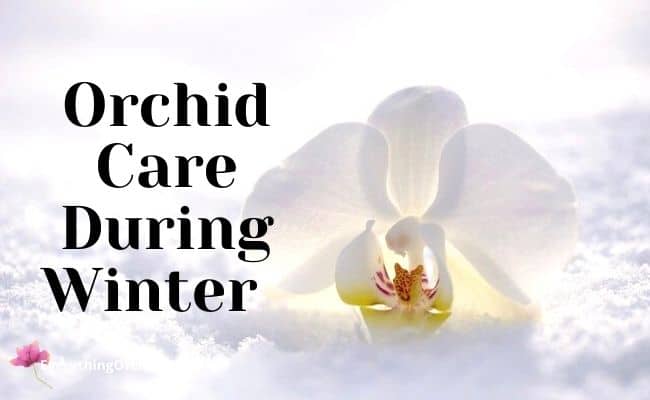Orchid care during winter can be a challenging task. Orchids are delicate plants and require certain dynamics and environments for their success.
Summer months cause orchids to thrive and grow, whereas during winter months, you may notice little-to-no activity with your plant. Winter may seem to last for what feels like forever and can take a toll on your plant.
Orchids are able to thrive during summer because of Mother Nature herself. Most regions during this season have long periods of sunlight, high humidity levels, and warm temperatures: the perfect ingredients for successful and beautiful orchids.
Winter on the other hand poses quiet a few challenges that may make orchid care during winter hard such as:
- Lack of sunlight
- Dry air and low humidity levels
- Cold temperatures
These challenges cause orchid growth to stall and even make cause your orchid to go dormant during this time. The lack of activity on your orchid may even cause you to think your plant is dead.
But knowing the proper things to do for orchid care during winter will help you as an orchid owner feel more at ease and will make your orchid seem as though it is thriving during summer.
FTC Disclosure: This website contains affiliate links. If you choose to purchase any items, EverythingOrchid will receive a commission at no additional cost to you.

Table of Contents
Orchids and Sunlight
Sunlight is an extremely important dynamic when it comes to an orchid’s health. Improper amounts of light can cause your plant to become seriously ill or even die.
Most orchid species require a lot of sunlight. Healthy orchids receive anywhere from 12 to 14 hours of sunlight each day.
The best way to make sure your orchid is receiving large amounts of sunlight is by placing your plant in a well-lit room.
I recommend placing your orchid near or in-front of a window in the brightest part of your house to make sure your plant gets the most amount of sunlight as possible.
Ways To Tell Your Orchid Isn’t Getting Enough Sunlight
There are several indicators and signs that tell your orchid isn’t getting enough sunlight including:
- The growth of your plant
- The color of the orchid leaves
- The thickness and size of the leaves
Lack of sunlight may cause your orchid to slow in growth. You may notice less activity on your plant.
Perhaps very few or no new roots are appearing. Perhaps you haven’t noticed new leaf growth in months. No new stems may be emerging, or maybe there hasn’t been any new blooms for long periods of time.
Another big indicator that your orchid isn’t receiving enough sunlight may be attributed to the color of the orchid’s leaves.
Orchid plants that receive proper amounts of sunlight appear bright green. Most orchid species that aren’t receiving enough sunlight will start turning a dark green color.
Other signs that your orchid isn’t receiving enough sunlight may be attributed to the size and thickness of the leaves. Healthy orchid leaves tend to be thick, heavy, and longer in length.
Orchid leaves that aren’t receiving enough sunlight may become thin and short in appearance. The leaves may also begin to become brittle and wilt away.
Sunlight and Orchid Care During Winter
Many places in the world during winter months may experience a significant decrease in the amount of sunlight each day. You may find that the area you live in only gets 10 hours or less of sunlight.
This causes orchid care during winter to be challenging since orchids require significant amounts of sunlight per day. As you may recall orchids require 12 to 14 hours of sunlight in order to stay healthy.
Mother Nature makes it impossible for orchids to naturally receive this amount of sunlight each day throughout most regions of the world during this time and you as an orchid owner may want to take different precautions to help the the living conditions of your plant.
To prevent depriving your orchid of the lighting it requires to stay healthy and alive you as an orchid owner may want to consider:
- Artificial lighting for your plant
- Placing your orchid in well-lit rooms
Artificial Lighting and Orchid Care
You can increase the amount of sunlight and improve your orchid care during winter by utilizing artificial lighting sources for your plant.
I recommend using artificial lights that are either LED or florescent. Use lights that have no more than 60-watt bulbs.
When installing your artificial light for your orchid, be sure to place the light at least 6 to 10 inches away from your orchid. Placing it too close may burn your plant.
I also recommend purchasing a timer for your light as well. This will enable you to control the amount of light your orchid will get (keeping the lighting consistent) and will automatically turn on and off each day (so you don’t have to remember).
For more information about artificial light for orchid care visit growing orchids under lights.
To purchase additional lights for your plants, check out the links below:
Orchids and Well-Lit Rooms
Regardless of the season, you should always place and display your orchid in a bright, well-lit room. Giving your orchid as much sunlight as you can, especially during winter, will help your orchid thrive and appear healthy.
Place your orchid near or in-front of a window. Do not place your orchid in a dark room, as this may cause your orchid’s health to rapidly deteriorate.
Even if you are using artificial lighting for your orchid, I still recommend placing your orchid in a bright room. Bright, well-lit rooms will help improve your orchid care during winter.

Orchids and Humidity
The majority of species of orchids are naturally found in tropical climates. Tropical climates tend to have high humidity levels.
Humidity levels play a key role in an orchid’s health. Humidity levels impact the air flow throughout your plant, and lack of humidity or dry air may cause your orchid to suffocate.
Humidity also helps with your orchid’s soil. Moist soil (usually sphagnum moss or bark) indicates that your orchid is well-hydrated and is receiving key nutrients that it needs to survive.
The best humidity levels for the majority of orchid species falls anywhere between 50% to 70% humidity. Anything less may cause serious health complications for your plant.
Humidity and Orchid Care During Winter
The humidity levels in most regions of the world during winter months tend to become dry and low.
Low moisture levels are not ideal for most species of orchids. Lack of humidity will cause your plant’s soil to become dry, which will go on to cause poor airflow and nutrient transportation throughout the orchid.
To keep up with humidity and airflow for orchid care during winter I suggest:
- Purchasing humidifiers
- Regularly water your orchid
- Place fans in the room your orchid is in
Humidifiers are useful tools to help increase the amount of humidity in the area where you place your orchid. Humidifiers will emit vapor or moisture into the air.
A humidifier will help maintain the 50% to 70% humidity levels orchids require to stay healthy. Humidifiers are perfectly safe to use and only require water to be effective. These will also help keep your skin and nose from drying out too!
To help with the dryness that winter may cause to your orchid, I suggest regularly watering your plant. The dry air that winter produces may cause the soil of your orchid to dry-out quicker than normal.
Dry soil will cause a series of unfortunate events for your orchid, including depriving it of key nutrients it needs to survive. You should check your orchid every several days, and in most cases you should only have to water your orchid every 7 to 10 days.
For more information on how to water your orchid checkout: How to Water Orchids
To help with airflow and to move moisture around the area in which you place your orchid, you should consider placing a fan near your plant.
A fan will increase airflow, which is essential to nutrient dispersion throughout the orchid. Fans and airflow will also help strengthen your orchid as well.
To purchase humidifiers for your plant and home, check out the links below:
Temperature and Orchid Care During Winter
Temperature plays a important role in the health and survival of orchids. Temperature and orchid care during winter can be a hard thing to overcome, since winter tends to bring freezing temperatures to most regions of the world.
Orchids are naturally found in warm, tropic-like climates. The best temperatures for this type of plant is between 65 and 75 degrees Fahrenheit.
Though warmer temperatures won’t harm these plants, anything colder than 65 degrees will become harmful to the orchid. Colder temperatures have the potential to cause freeze burns, shock and stalled growth of the orchid, or death of the plant.
It is not uncommon for most places during winter to experience freezing temperatures (below 32 degrees Fahrenheit), causing many of us to have to crank up the heat.
But this can become expensive, and you may even experience super drafty windows and doors that make it seem as though the heat isn’t even on. Even with all your efforts to keep your home warm, it still may be too cold for your orchid.

Ways to Increase Temperatures
The best tips I can offer to make sure your orchid is getting the best temperatures for orchid care during winter is by:
- Using portable heaters
- Using artificial lights
- Moving your orchid away from drafty areas
Portable heaters are a cheaper and easy alternative to heating areas in your home. They are also useful if you experience significant drafts throughout your house as well. Portable heaters are also a good way to make sure your orchid is getting enough heat too.
Since they are portable, you will be able to place them near the orchid (but not too close–try to place it several feet away). Be sure to set the heater to at least 65 degrees Fahrenheit for best results.
Artificial lighting again can be a useful tool to help your orchid, and can help provide proper heat and temperatures for your orchid care during winter.
Lights of any kind act as a heat source, and whether you are using LED lighting or florescent lights, your orchid will be receiving heat.
If you notice significant drafts in the areas your orchid may be displayed, then you may want to consider moving your orchid, especially if it is near a draft window.
I would recommend combining all these tips, as portable heaters, artificial lighting, and moving the plant to better heated areas can all provide the best temperatures for your orchid during winter.
To purchase portable heaters for your orchid, check out the links below:
Orchid Care During Winter: Summarized
Winter tends to be a cold, gloomy time for many of us. But having a healthy, beautiful orchid can help brighten this season up.
Orchid care for winter can be challenging, as Mother Nature deprives us and our plants of key things such as sunlight, humidity, and warm weather.
Sunlight, humidity, and warm temperatures are all essential for healthy orchids.
But since there is short periods of sunlight each day, dry air, and freezing temperatures during this season, spells issues for your orchid. You may notice a lack of growth from your plant, dry soil, dying leaves, or a dying plant.
To prevent these issues from happening you should consider:
- Placing your orchid in well-lit rooms
- Using artificial lighting for your plant
- Place humidifiers in the room your orchid is in
- Use portable heaters
- Move your orchid away from drafty areas
- Use fans for airflow
I hope this blog post has been helpful and informed you on the best tricks to improve your orchid care during winter.
FTC Disclosure: This website contains affiliate links. If you choose to purchase any items, EverythingOrchid will receive a commission at no additional cost to you.
